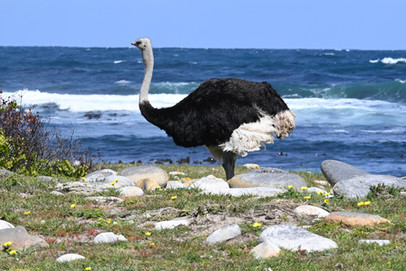Penguins and The Cape of Good Hope
- Pam Carey-Mackenzie
- Sep 21
- 2 min read
We spent a day exploring the coast south of Cape Town. If you know me you know how much I LOVE penguins. So I had been greatly anticipating this day and the chance to see African Penguins up close!
We started with a drive along the south coast of Cape Town en route to the penguins and the Cape of Good Hope. We got to see many of the wealthy and beautiful beach communities of Cape Town; Camps Bay, Clifton (the wealthiest) and Sea Point. This drive reminded me of driving down highway one near Los Angeles. Here are a few pictures:
We arrived at Boulders Beach near Simon's Bay where there is a large African Penguin Colony. A few African Penguin facts:
called a Cape penguin or South African penguin,
a species of penguin confined to southern Africa
are called 'jack ass penguin' due to the donkey like sound they make
is flightless, with a streamlined body and wings stiffened and flattened into flippers for a marine habitat
adults weigh an average of 4.9–7.7 pounds and are 24–28 inches tall
the species has distinctive pink patches of skin above the eyes and a black facial mask. The body's upper parts are black and are spotted and marked with a black band
As you can imagine I took hundreds of photos and then edited them down to 75 but I will only show you a few!
Don also took this video of the penguin that greeted us. How fun!!
We then drove to The Cape of Good Hope. A few facts:
From Storms to Hope: It was first named the "Cape of Storms" by Bartolomeu Dias in 1488 due to the treacherous conditions and numerous shipwrecks, but later renamed the "Cape of Good Hope" by King John II of Portugal as a positive sign for reaching the East by sea
Not the Southernmost Tip: Many people confuse it with the southernmost point of Africa, which is Cape Agulhas. The Cape of Good Hope marks the south-westernmost point of the continent
Wildlife Encounters: You can see diverse animals in the reserve, such as Chacma Baboons, ostriches, and of course African penguins - we saw all!
Whale Watching: During the whale season, typically from June to October, you can spot whales from the coastline
A Navigational Landmark: The Cape served as a crucial landmark during the Age of Exploration, though its dangerous waters also made it a "ship graveyard"
The Cape Point Lighthouse: A prominent lighthouse was built on Cape Point to warn ships of the rocky shores, though the first attempt was too high and ineffective.
We were able to take a tram to the high point and walk up to the lighthouse.
Another exciting day of exploring Cape Town and it's surrounding areas!
Thanks for following.













































Comments